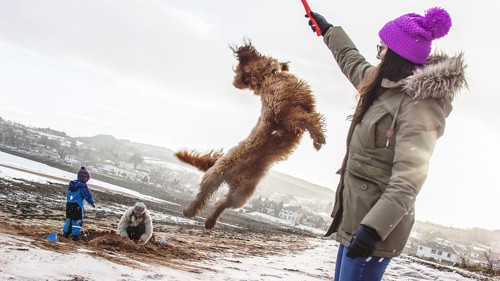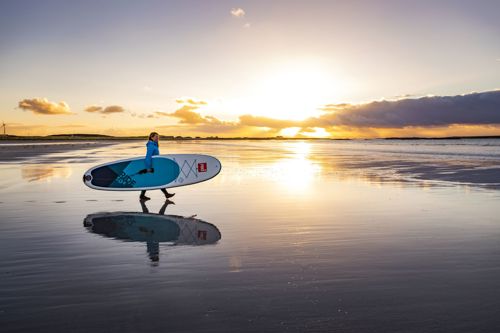Mobile menu
24 November 2024
Holidays on the west coast all-year round – winter, spring, summer and autumn

The concept of Scotland exists in the imagination of many, each fantasy taking place at a different point in the calendar – the sun-drenched beach, the springtime hike, the winter log cabin – but in truth the reality is so much more.
Each of Scotland’s seasons brings with it a chance to experience unique opportunities or to rediscover beloved destinations in a new light. Some islands become synonymous with a certain phase of the year – through photographs or blogs – but at CalMac we know that these iconic locations shine all year round.
Whatever the season we’re there for you, working hard to maintain our network of routes and connect Scotland’s west coast islands for residents and visitors alike. Travelling with CalMac means the adventure starts the minute you board our vessel – treat yourself to fresh food, a cold beer or a hot drink as we whisk you across the water to your destination. Here are some ideas for your next trip, all year round.
Winter
Arran
Long seen as an island escape during the summer months, Arran also has loads to offer for a quick winter getaway. When the weather is starting to chill, the island might not appeal for mountain hikes or extended cycles but the other side of Arran’s character comes into play – that of spa days, gourmet meals, distillery visits and luxury local produce. Walk along the awe-inspiring promenade at Lamlash to see Arran in all its wintertime glory before retiring to a local inn to savour some of the locally crafted Arran Ales or perhaps a wee board of the famous Arran Cheese – the perfect winter escape. And the best bit is that it’s just over the water from Ardrossan harbour, served by its own train station with links direct from Glasgow Central. Enjoy a freshly prepared ‘CalMac n Cheese’ as the ferry makes its crossing in less than an hour to Brodick.

Colonsay
Colonsay might appear to be a bold choice for a winter break but we think its magical combination of stunning scenery, active wildlife and strong community make it the ideal location for the colder months. Blow the cobwebs away with a walk along Kiloran Bay, the longest and most spectacular beach on Colonsay, or explore 15th century graveyards and iron-age duns at one of the most dramatic points in the calendar for the full historical atmosphere. Or do what people have done for generations and enjoy the long nights with a warm fire and a cold drink – perhaps from one of Colonsay’s award winning Gin distilleries.
Spring
Bute
There are very few places that can match Bute in the spring sunshine. Watch the light play amongst the Victorian architecture in the main town of Rothesay before strolling along the beautiful beaches that outline the island. Visiting in spring means you’ll also get to enjoy a day at the exquisite Mount Stuart House before the rush of the summer season kicks in. Take your time and marvel at this gothic masterpiece as the flowers of the gorgeous gardens begin to blossom. With crossing just a short hop from the mainland at Wemyss Bay, you can enjoy a refreshment from our onboard Coffee Cabin as you take in the views of the journey.

Lewis
The wonderful island of Lewis has much to offer as the days get longer. It’s the perfect time of the year to discover some history hidden in plain sight. The Calanais Standing Stones are a Neolithic monument some 5,000 years old. Predating Stonehenge, this historic wonder is a must-see when visiting Lewis – particularly when nature is renewing herself around them as she has for millennia before us. Delights of nature continue with camping along the Hebridean Way or attractions with a more modern twist can be found in Stornoway where fabulous restaurants, welcoming bars and great art – courtesy of local venue An Lanntair – create a formidable landscape to usher in the changing of the seasons.
Summer
Mull
Summer on Mull is a treat, a myriad of attractions that perfectly capture what makes the island so special. Tobermory’s pastel beauty feels tailor-made for a summer’s day when the town’s picturesque backdrop transforms into a postcard perfect view that needs to be seen to be believed. Elsewhere on the island you’ll find that the warm weather lends itself to a whole host of outdoor activities – cycling, kayaking, wild swimming – there’s opportunity to explore Mull from every perspective. Take the ferry over from Oban for a quick day trip or a longer stay, perhaps treating yourself to a locally made ale from our onboard bar on the way.

Tiree
What better time to visit the ‘Hawaii of the North’ than the height of summer? Known for its large quantities of sun and a warm gulf stream, Tiree is an island paradise perfectly suited for a Scottish getaway. Its vast array of pristine white sand beaches also lend the island the illusion of a tropical paradise in the summer months, making it the ideal location to soak up some rays without ever leaving the country. The famous Tiree Wave Classic – a major competition for windsurfers from around the world – might not happen until October but there’s still plenty of opportunity for outdoor adventures during the summer months. Whether you’re taking your first splash into learning surfing or looking for a genteel cycling route for the family, Tiree is only more than happy to oblige.
Autumn
Skye
While the crowds flock to Skye in the busy summer months for the beautiful landscapes and famous sites, the island reveals itself as Autumn approaches – the turning of the leaves marking a period of space and reflection for the island and those who visit her at this time. The Fairy Pools, the Cuillin, the Old Man of Storr – these natural wonders are waiting to be rediscovered and experienced anew in the autumn light – reclaimed by nature with the roads free to explore. From Dunvegan’s ancient castle to Portree’s village buzz, the legendary Talisker distillery to the beautiful port of Uig; Skye has so much to offer after the summer rush has bled into the autumn chill.

Barra
Barra is the perfect starting point for an autumnal jaunt along the spectacular arc of the Outer Hebrides. Take the ferry from Oban to Castlebay and discover an island that thrums to the rhythm of a vibrant community spirit. Barra has long been vaunted for its unique island culture and legendary nights out, the perfect accompaniment to the changing of the seasons. Eat at family run restaurants and experience a night of live music while you mingle with locals and let your hair down before working your way north on CalMac’s network of services across the Hebrides.
No matter the location, no matter what time of year – CalMac is here to get you where you need to go. Whether it’s island hopping itineraries or a quick weekend getaway, Scotland is waiting – all year round.


